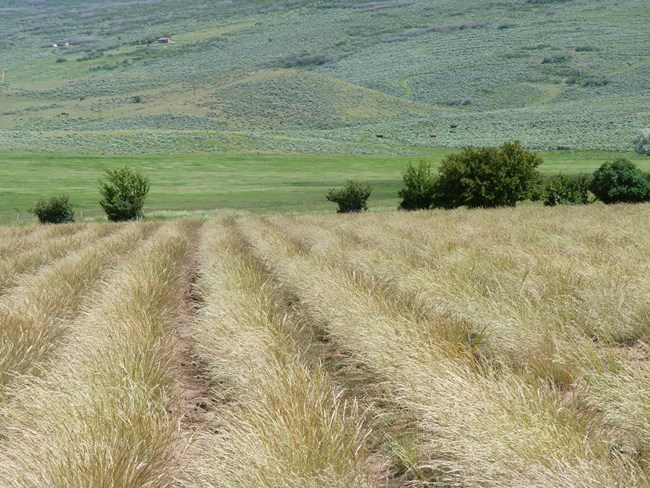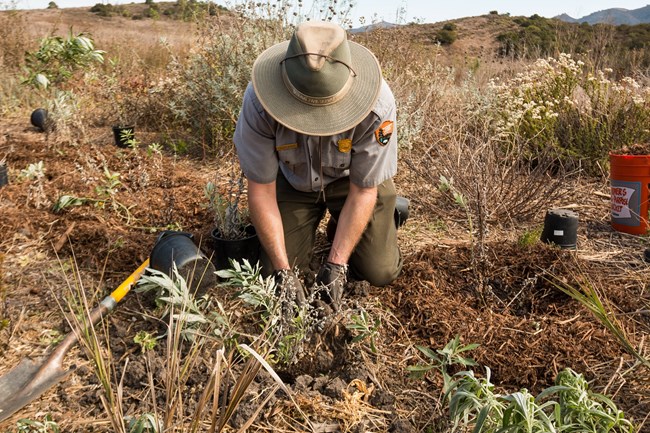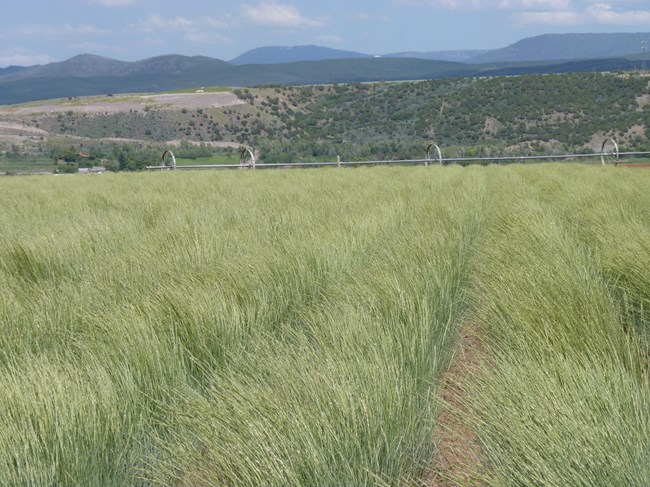Last updated: December 18, 2024
Article
Park Managers look to Bipartisan Infrastructure Law projects to break cycle of fire-driven ecosystem losses in the West
Fire is a normal part of many ecosystems, but in recent decades it’s meant near permanent loss of sagebrush in many parts of the American West. Warmer, drier conditions caused by our changing climate often push natural fire into megafires that leave sagebrush country scorched. Invasive annual grasses introduced from parts of North Africa and Eurasia provide the fuels to accelerate these fires and can aggressively move in and squeeze out burned sagebrush remnants and the relatively small stock of seed or seedlings restoration ecologists can bring to the field.

UCEPC / Steve Parr
As warmer, drier conditions move northward and upslope, national park and other public land managers on the Colorado Plateau, the central and northern Rocky Mountains, can visualize fire devastating currently intact sagebrush habitat. “It’s a horrible scenario for the vegetation and wildlife resources of these places,” said National Park Service ecologist Steven Bekedam. “But we can do something about it because of funding opportunities provided by the Bipartisan Infrastructure Law.”
Bekedam and his peers across the Colorado Plateau and central and northern Rockies are quickly designing and implementing infrastructure law funded projects to increase production of native seed and seedlings of workhorse species of plants to break the cycle of fire followed by invasion of nonnative plant species.
Sagebrush may not be the first image that comes to mind when visualizing the Rocky Mountains, but it’s there in the form of a rich mosaic of thousands of diverse plant species, which are largely driven by differences in climate, soil and elevation that are critical foraging areas for park wildlife populations. These distinct sagebrush plant and animal communities cover three million acres in 70 parks across the American west.
After a wildfire, invasive annual grasses are better competitors for variable amounts of spring precipitation and grow more quickly, replacing diverse native sagebrush ecosystems with simplified invaded ones. There are many different troublesome invasive plants, but cheatgrass is among the most well-known and widespread.
“We call it the cheatgrass-wildfire cycle,” said Bekedam, who hangs his hat at Yellowstone National Park. “Cheatgrass and other invasives gain a foothold which then become explosive fuels for the next fire allowing cheatgrass to become even more pervasive. Parks in the Great Basin have been experiencing these conditions for years.”
For higher elevation areas of parks above 7,000 feet, Bekedam said ecologists didn’t fully realize how quickly these warmer, drier conditions were coming. “We want to get ahead and have enough native seed so when wildfires return, we can respond quickly, before annual invasive plants take over,” he said.

NPS / Connar L'Ecuyer
The project focus, as part of a larger program that the National Park Service calls its NPSage Initiative, is on collaborative work to build capacity across four priority seed zones of the Intermountain Region: 17 parks in the Colorado Plateau and Rocky Mountains ecoregions of Arizona, Colorado, New Mexico, Utah, and Wyoming. Project elements include activities to scale up regional collection, production, and storage of genetically appropriate native seeds so restoration crews can respond quickly to disturbances in sagebrush country.
These efforts also directly support the National Seed Strategy and related efforts such as the Department of Interior’s Sagebrush Keystone Initiative to defend and grow sagebrush core habitats and enable parks to better meet restoration goals with use of native seed. Local native seed is produced by native plant communities – populations of plant species that evolved and occur naturally in an area or region. Native plant communities are crucial for maintaining native biodiversity and providing key ecosystem services like conservation of water, erosion protection, and habitat and forage for wildlife. Seeds from less similar plant communities and even non-native species may initially germinate but would reduce genetic integrity of park resources and may have a negative effect on existing native plant communities where it is planted.
Parks are grouped based on their shared revegetation needs and occurrence within the same seed transfer zone – the largest area where seed can be considered native and have the best chance for success in restoration efforts. Bekedam said, “We’ll work with regional commercial seed growers to produce critical workhorse plant materials that can be shared across parks that share the same seed transfer zone.”
Park groupings in this project:
-
Black Canyon of the Gunnison National Park, Curecanti National Recreation Area, Florissant Fossil Beds National Monument, and Great Sand Dunes National Park and Preserve.
-
Colorado National Monument, Mesa Verde National Park, Arches and Canyonlands national parks, Hovenweep and Natural Bridges national monuments.
-
Grand Teton National Park, John D. Rockefeller National Memorial Parkway, and Yellowstone National Park.
-
Glen Canyon National Recreation Area and Lake Mead National Recreation Area.

UCEPC / Steve Parr
Bekedam said, “It’s important to get going quickly, and we have, but increasing seed stocks isn’t quick work. The infrastructure law provides critical funding for five years and that lets us focus on a long-term strategy to build up and to continue to be able to produce genetically appropriate native seed for future restoration needs.”
Recovery will take two to three years of solid plant establishment and three to four years for plant and animal communities to develop and be more resilient. This timeline requires a significant effort to keep out invasive plants so that native forbs, grasses and sagebrush establish themselves. The control efforts mean careful applications of pre-emergent herbicides when native plants are dormant in early spring or late fall.
The earliest project field work took place in late summer 2022. Crews harvested several pounds of starter seed which was planted in the spring of 2023 at private nursery facilities such as the Upper Colorado Environmental Plant Center in Meeker, Colorado. Plant establishment and seed production from forbs and grasses requires several years and parks started to receive seed in the fall of 2024.
Tags
- arches national park
- black canyon of the gunnison national park
- canyonlands national park
- capitol reef national park
- colorado national monument
- curecanti national recreation area
- florissant fossil beds national monument
- grand teton national park
- great sand dunes national park & preserve
- hovenweep national monument
- mesa verde national park
- natural bridges national monument
- yellowstone national park
- bipartisan infrastructure law
- ecosystems
- ecosystem restoration
- national seed strategy
- npsage
- ki-sagebrush
- wildland fire
- inflation reduction act
